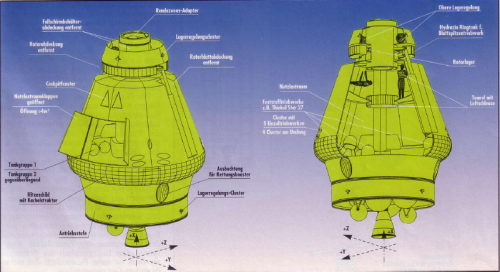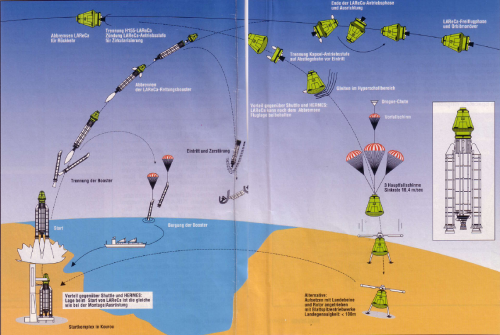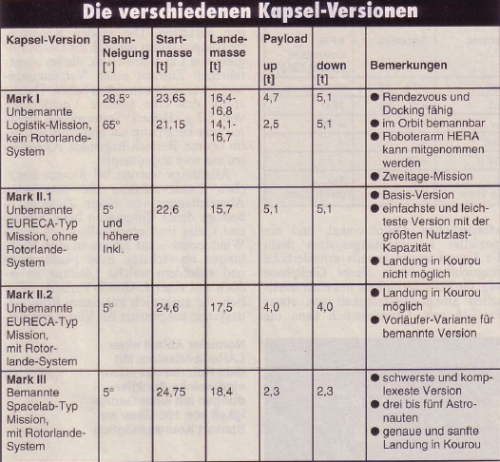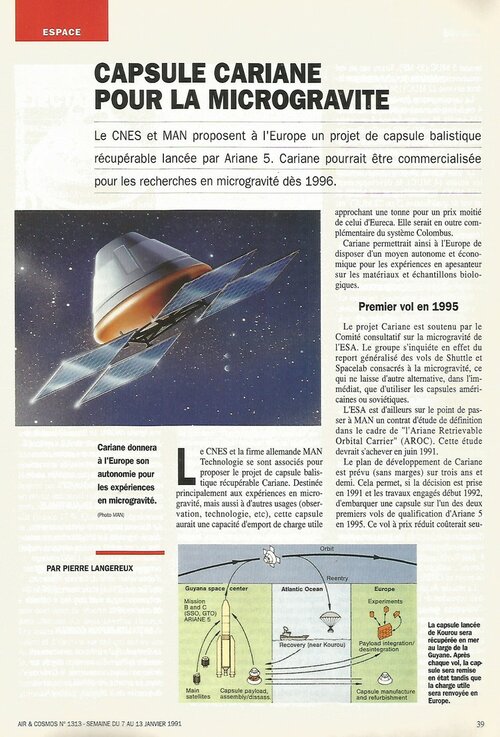- Joined
- 13 August 2007
- Messages
- 7,880
- Reaction score
- 9,007
As ESA discuss European Manned Spaceflight was a battle between Hermes Shuttle and Capsule Fraction
Here the 1989 Proposal of ERNO "LaReCa" short for Large Ariane 5 Return Capsule
It feature:
-A large reusable Capsule for various mission
-The use of full potential of Ariane 5 rocket
-Mission preparation and maintenance in Europe
-Use of Airbus Beluga for transport of Capsule to launch site
-Horizontal layout make it easy to access the Payload and crew on Launch pad
The Capsule is 7.3 meter in Diameter
it feature a large cargo bay with 110 cubic meter and Cockpit with 30 cubic meter space
The Cockpit got place for 3 to 5 astronauts for maximum mission of 12 days
The Cargo bay can be open by 4 square meter door while the Cockpit is sealed, while cargo can move out with HERA robot arm
if not needed the cargo bay door is close and a atmosphere in keep in Cargo bay
on Capsule is a Servis module attach
it feature bipropellant rocket engine and Reaction control system for get into Orbit and maneuver and Docking and deorbit burn
Fuelcell for Power supply and radiator of thermal control system
the Service module is drop after debris burn and disintegrated on reentry
Launch feature interesting feature
the LaReCa got three solid rocket who incase of Ariane 5 failure, ignite and pull the Capsule from Service module.
In that case the capsule got two option landing in Atlantic or land near launch site.
if all goes well and booster of Ariane 5 are drop the three solid rocket ignite and help the Core stage !
This Ariane 5 consisted only two Booster and Core Stage, the LaReCa service module serve as second stage
the Capsule feature unique reentry system
next to Apollo reentry control system allowed to correct it flight pad for 100 to 150 km
follow by 3 parachute to reduce descent speed to 16/meter while four landing legs are deployed.
under this condition the Capsule can land on surface with force of 5.7G survivable for astronaut in there seats
but that only the case if Rotor landing system fails
At decent of 7.5 meter /second the parachute is drop and 4 rotor blade are deployed (stored at the side of Capsule in two notch
this system allow point landing by litte engine in Rotorblades and Apollo reentry control system
either remote controlled from french Korou or full automatic
Several Mission and Version of LaReCa
Mark 1
unmanned logistic craft to space station, without Rotor landing system
Tow day mission, automatic renders and docking, crew access to LaReCa, use of Robot arm HERA from Payload bay
launch mass 23.65 tons into 28°, or 21.15 in 65° orbit
landing mass 16.8~14.1 tons
Payload Up 4.7 tons into 28°, or 2.5 tons in 65° orbit.
Payload Down 5.1 tons
Mark II.1
Basic version for unmanned EURECA mission, without Rotor landing system
Landing in Korou not possible
launch mass 22.6 tons into 5° or higher inclnation orbit
landing mass 15.7 tons
Payload Up 5.1 tons
Payload Down 5.1 tons
Mark II.2
unmanned EURECA mission, with Rotor landing system and precursor for Manned version
Landing in Korou possible
launch mass 24.6 tons into 5° orbit
landing mass 17,5 tons
Payload Up 4 tons
Payload Down 4 tons
Mark III
Manned version for Spacelab mission in Payload bay and 3 to 5 astronaute
precise soft Landing in Korou
launch mass 24.75 tons into 5° orbit
landing mass 18,4 tons
Payload Up 2.3 tons
Payload Down 2.3 tons
Source:
Gerd Zelck, Aerospace engineer who work in ENRO for Shuttle Spacelab
publish in German FlugRevue issue 3/89 page 79 and issue 12/1993 page 32
http://gerd-zelck.de/dokumente/flug-revue-1993-12_kapsel-losung-wieder-aktuell__farbe.pdf
Here the 1989 Proposal of ERNO "LaReCa" short for Large Ariane 5 Return Capsule
It feature:
-A large reusable Capsule for various mission
-The use of full potential of Ariane 5 rocket
-Mission preparation and maintenance in Europe
-Use of Airbus Beluga for transport of Capsule to launch site
-Horizontal layout make it easy to access the Payload and crew on Launch pad
The Capsule is 7.3 meter in Diameter
it feature a large cargo bay with 110 cubic meter and Cockpit with 30 cubic meter space
The Cockpit got place for 3 to 5 astronauts for maximum mission of 12 days
The Cargo bay can be open by 4 square meter door while the Cockpit is sealed, while cargo can move out with HERA robot arm
if not needed the cargo bay door is close and a atmosphere in keep in Cargo bay
on Capsule is a Servis module attach
it feature bipropellant rocket engine and Reaction control system for get into Orbit and maneuver and Docking and deorbit burn
Fuelcell for Power supply and radiator of thermal control system
the Service module is drop after debris burn and disintegrated on reentry
Launch feature interesting feature
the LaReCa got three solid rocket who incase of Ariane 5 failure, ignite and pull the Capsule from Service module.
In that case the capsule got two option landing in Atlantic or land near launch site.
if all goes well and booster of Ariane 5 are drop the three solid rocket ignite and help the Core stage !
This Ariane 5 consisted only two Booster and Core Stage, the LaReCa service module serve as second stage
the Capsule feature unique reentry system
next to Apollo reentry control system allowed to correct it flight pad for 100 to 150 km
follow by 3 parachute to reduce descent speed to 16/meter while four landing legs are deployed.
under this condition the Capsule can land on surface with force of 5.7G survivable for astronaut in there seats
but that only the case if Rotor landing system fails
At decent of 7.5 meter /second the parachute is drop and 4 rotor blade are deployed (stored at the side of Capsule in two notch
this system allow point landing by litte engine in Rotorblades and Apollo reentry control system
either remote controlled from french Korou or full automatic
Several Mission and Version of LaReCa
Mark 1
unmanned logistic craft to space station, without Rotor landing system
Tow day mission, automatic renders and docking, crew access to LaReCa, use of Robot arm HERA from Payload bay
launch mass 23.65 tons into 28°, or 21.15 in 65° orbit
landing mass 16.8~14.1 tons
Payload Up 4.7 tons into 28°, or 2.5 tons in 65° orbit.
Payload Down 5.1 tons
Mark II.1
Basic version for unmanned EURECA mission, without Rotor landing system
Landing in Korou not possible
launch mass 22.6 tons into 5° or higher inclnation orbit
landing mass 15.7 tons
Payload Up 5.1 tons
Payload Down 5.1 tons
Mark II.2
unmanned EURECA mission, with Rotor landing system and precursor for Manned version
Landing in Korou possible
launch mass 24.6 tons into 5° orbit
landing mass 17,5 tons
Payload Up 4 tons
Payload Down 4 tons
Mark III
Manned version for Spacelab mission in Payload bay and 3 to 5 astronaute
precise soft Landing in Korou
launch mass 24.75 tons into 5° orbit
landing mass 18,4 tons
Payload Up 2.3 tons
Payload Down 2.3 tons
Source:
Gerd Zelck, Aerospace engineer who work in ENRO for Shuttle Spacelab
publish in German FlugRevue issue 3/89 page 79 and issue 12/1993 page 32
http://gerd-zelck.de/dokumente/flug-revue-1993-12_kapsel-losung-wieder-aktuell__farbe.pdf





